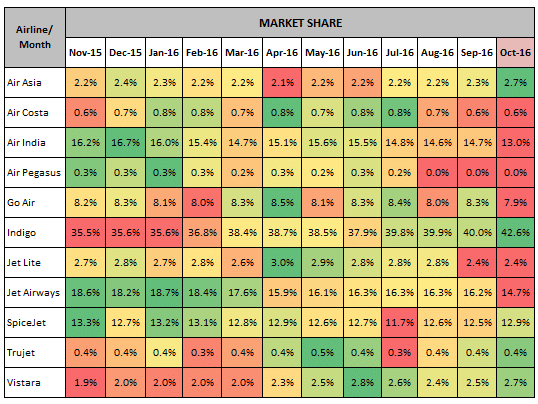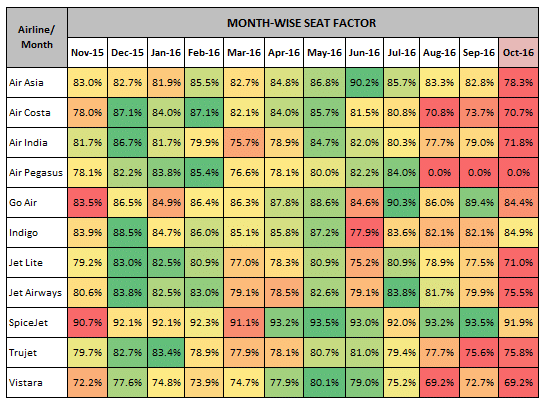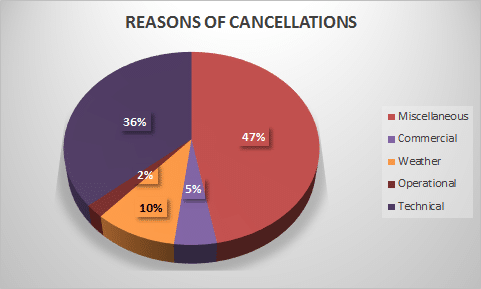We bring you the “Domestic Airlines Report Card for India” for the month of October, 2016. We take a look at the Number of Passengers carried, Market Share of Each Carrier, Passenger Load Factor and others. (Here is the Report Card for September, 2016)

Passengers Carried and Market Share
The total number of passenger carried during the month of October, 2016 stood at 86.72 lakh compared to 70.39 lakh during the same month of the previous year. This resulted in a growth of +23.20% (YoY).

The total number of passenger carried for the period January to October, 2016 stood at 813.7 lakh compared to 660.6 lakh during the same month of the previous year. This resulted in a growth of +23.18% (YoY).

Indigo Airlines – the market leader with garnering 42.6% of the market share, carried 36.93 lakh passengers compared to 25.90 lakh passengers during the same month of the previous year, resulting in a growth of 43%. This means Indigo carried 4 lakh passengers more than in September while the same figure for the previous year stood at 1.6 lakh passengers.

Indigo also announced their Q2 results on 8-Nov. Here is a short summary:
- Indigo added Port Blair as the 36th domestic destination and 41st destination overall
- Indigo is targeting a fleet size of 136 by March 31, 2017 from the current 118 – Indigo plans to add 18 additional aircraft to from Oct’16 through Mar’17 by induction of used aircraft on short term leases.
- Indigo added 9 aircraft to its fleet size which expanded its fleet size to 118 (6 new A320neos and 3 used A320ceos on short-term operating leases), it did not receive any new deliveries in October, 2016.
- While 10 A320neos have been delivered as per Airbus data, Indigo has reported induction of only 9 A320neo to its fleet size.
- While Airbus September order book confirmed that Indigo had an order of 430 A320ceo of which 10 were delivered by September, the order book for October has now confirmed the rumours of the company choosing to shift the order book – its revised order stands at 410 A320ceo and a new order for 20 A321neo.
Here is the Q2 FY17 Revenue breakup that the company reported earlier this month

Come 2017, Airbus will increase the production of A320 Family aircraft to 50 per month in 2017 and then to 60 a month in mid-2019. To enable the production ramp-up, an additional production line is being built in Hamburg, which is being financed by equity, and will be operational in 2017.

This means that with an outstanding order of 410 A320neo for Indigo, at a rate of 25 per month (tall order of 50% of its production being delivered to Indigo), it would be until mid 2018 or May 2018 for the company to completely overhaul its current fleet. Airbus expects the transition from A320ceo (current engine option) to A320neo (new engine option) to finish in 2019 as it is currently focused on ramping up the slower start of PW engine deliveries for A320neo.
Pratt & Whitney has been facing a disruption in the output of the A320neo due to manufacturing delays. From a delivery target of 200 engines (8,400 engines on order), it is now targeting 150 engines for this year as it hasn’t been able to produce certain parts fast enough (including the lightweight hybrid aluminum-titanium fan blades used in the engine). Pratt has encountered glitches in moving its more fuel-efficient and quieter geared turbofan models into production. Problems have included overly long start-up times and have delayed production of the Airbus A320neo planes.
Indigo’s President Aditya Ghosh said that the company is closely watching the performance of CFM’s competing powerplant. The A320neo is also powered by engines made by CFM International, a venture between General Electric Co and Safran SA. CFM hasn’t seen delays.
A320neo’s have been marred by several engine issues one of which includes a cooling problem with the powerplant which required operators to delay start-up under certain conditions so it could reach the right operating temperature. This meant that the motor-to-start cycle requirements stood at around 3min more than double the industry standard of about 1min.
Passenger Load Factor
Passenger load factor, or load factor, measures the capacity utilization of public transport services. It is generally used to assess how efficiently a transport provider “fills seats” and generates fare revenue.
Barring Spicejet and Indigo, all the other operators reported their worst Load Factor in the past 12 months. While Spicejet managed 91.9% – its third worst in 12 months, Indigo reported 84.9%.

Cancellations
The overall cancellation rate of scheduled domestic airlines for the month of October, 2016 has been 0.7%. The Overall cancellation rate is generally influenced by bad weather, unfavorable flight conditions, low visibility, conditions at airports etc.





